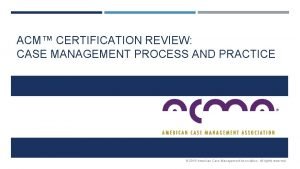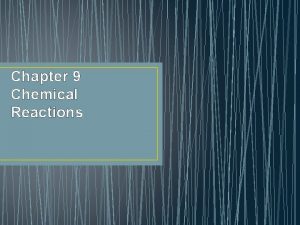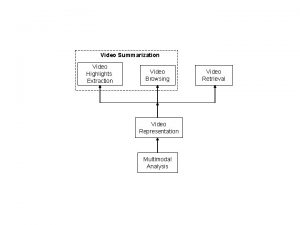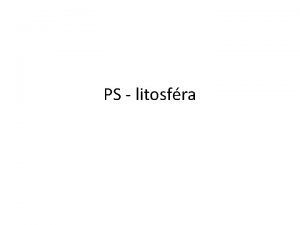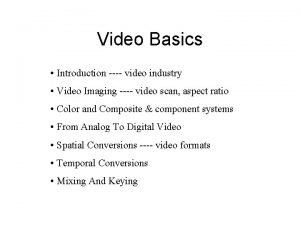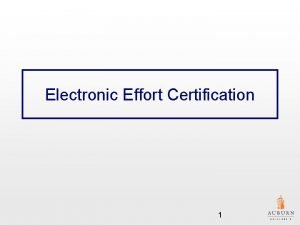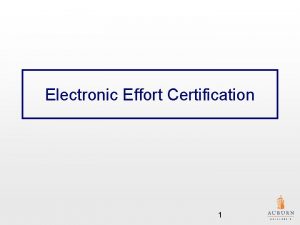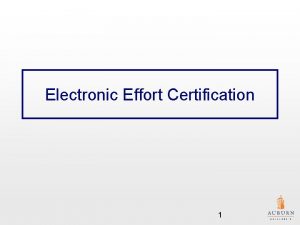A Certification Guide Chapter 7 Video Chapter 7























- Slides: 23

A+ Certification Guide Chapter 7 Video

Chapter 7 Objectives § Video (Graphics) Cards Types and Installation: – – § Describe the different types of video cards, including PCI, AGP, and PCIe, and the methods of cooling video cards. Understand video card installation and driver setups. Display Types: – § § Describe CRTs, LCDs, and data projectors. Install a Video Card Video Connector Types: – § § Describe VGA, DVI, and HDMI. Configure Resolution and Refresh Rate Troubleshooting Displays and Video Cards: – – Show to use OSD and the advanced display properties. Describe how to clean display and clean/maintain airflow.

Video (Graphics) Card Types In order of appearance on the market: § On Board: – Found on most motherboards – Generally low quality but some high-end available on better motherboards § PCI: – Legacy § AGP: – Pentium II – Pentium IV § PCI Express (PCIe): – Multicore machines

Video RAM § Why have video RAM? – § Video RAM is on the video graphics card. Review: Motherboard RAM—What is it used for? – – § Memory addresses—Allocated by CPU/ memory management system. CPU generally takes data directly from RAM. Video display is memory-intensive: – – – CPU sends raw data to video card. RAM on video card allows processing to occur before sending it to display. Conclusion: Video RAM is a buffer between the RAM data and the display-ready data.

Video Card Cooling § GPU (Graphics Processing Unit): – – § CPU for graphics cards Can overheat without provision for cooling Cooling provided by – – Passive heat sinks: • No moving parts Active cooling: • Powered fans mounted on GPU Cooling devices need to be kept clean of dust. Air flow around GPU should be unrestricted.

Display Types § § § CRT monitors: – Mostly on older systems. – Dot pitch determines quality of resolution. LCD monitors (liquid crystal display): – Quality of dot pitch catching up to CRT. – Refresh rate expressed in milliseconds. – Can use either analog (VGA) or digital (DVI) inputs. LED – LCD with LED source light Plasma – used in TVs that double as PC monitors Data projectors: – Can be either LCD or DLP (digital light projection).

LCD Projector Image Processing

Installing a Video Card 1. Configuring the BIOS for the video card being installed: – AGP settings. – Set Primary Graphics Adapter. – Graphics aperture—use default. 2. Physically installing the video card: – System off; ESD protection employed. – Remove old video card/cable if necessary. 3. Installing drivers for the video card: – Initial setup is done by Pn. P. – Advanced setup usually requires driver installation.

Installing Video Card

Video Connector Types § § § VGA: – 15 -pin female port connector – 15 -pin cable—male ends DVI: – DVI-I—analog and digital – DVI-D—digital-only HDMI (High-Definition Multimedia Interface): – Supports 1080 p HDTV – Specialized cable and connector – Supports both video and audio data Component RBG (Red/Blue/Green) S-Video Composite

Video Connectors

DVI to VGA Converters

Installing a Monitor § § § Match up appropriate cable: – DVI or VGA Choose refresh rate: – See manufacturer’s instructions. Connect the cable: – Be careful not to damage male pins. Display properties sheet and select settings. Go to Advanced Dialog for further adjustments: – May need to install driver

Display Settings § § § Resolution (pixel dimensions): – Horizontal width in pixels by vertical height in pixels. – Example: XGA is 1024 wide x 768 high. – Can be modified in display settings. Color quality: – Measured in bits/results in amount of colors. • 16 bits provides 65, 386 colors. • 32 bits provides 4. 3 billion colors. Refresh rates: – Low refresh can produce flickering images on-screen. • 70 Hz or higher is best on CRT. – LCD screens do not flicker. • 60 Hz is adequate.

Windows XP Display Properties

Advanced Display Adjustments Advanced Display Properties for Troubleshooting enables you to – Adjust text size with the DPI setting. – Adjust refresh rate to reduce flicker. – Click the Driver tab to update driver. – Use hardware acceleration selection to adjust mouse/pointer settings. – Use Full Screen 3 D to lighten the screen for 3 D games.

Windows 7 Display Properties

Troubleshooting Displays and Video Cards § OSD (On. Screen Display): – Activate by pushing the adjustment buttons on the monitor/display. – Adjustments: • Horizontal picture size • Horizontal picture centering • Vertical picture size • Vertical picture centering • Contrast • Brightness

Situations Requiring OSD Adjustments

Troubleshooting Video Hardware CRTs: • • Degaussing removes distortion around edges. Flickering caused by bad/loose cable. Wavy lines caused by electromagnetic “noise. ” Poor picture quality may be helped by – Improved resolution. – Change to a more correct refresh rate. LCDs: • If no picture, reselect the source—vga, hdmi, dvi. • Colored dots on an LCD projector indicate a need for internal cleaning of LCD panels. • Picture size is misaligned. – Change resolution.

Preventative Maintenance for Displays § § § Do not block ventilation holes. Use antistatic cleaners to clean screens and other surfaces. Do not spray cleaners directly onto screens or enclosures. Use thumbscrews at end of cable connectors to secure cables. Blow dust off video card when case is opened. Allow for as much airflow space as possible around video card.

What Have You Learned? – – – What is refresh rate? How do you change the resolution? What is OSD? What is VRAM? How would you resolve a problem with an LCD projector in which the picture on the screen is not capturing all the picture on the PC? What are the preventative maintenance concerns regarding the monitor that a technician should pay attention to when servicing a computer?

Chapter 7 Summary § Video (Graphics) Cards Types and Installation: – Describe the different types of video cards and the methods of cooling video cards. – Understand video card installation and driver setups. – Describe VGA, DVI, and HDMI. § Display Types: – Describe CRTs, LCDs, and data projectors. – Demonstrate how to install and configure a video monitor. § Troubleshooting Displays and Video Cards: – Show to use OSD and the advanced display properties. § Preventative Maintenance for Displays: – Describe how to clean display and clean/maintain airflow. Next Lesson: Chapter 8
 Yandex ru video search text
Yandex ru video search text Gravity yahoo
Gravity yahoo Video search yahoo
Video search yahoo The frame size of a video refers to the video’s
The frame size of a video refers to the video’s Nc paralegal certification
Nc paralegal certification Acm case management
Acm case management Certification study guide: certified hvac designer (chd)
Certification study guide: certified hvac designer (chd) Cic certification study guide
Cic certification study guide Cic certification study guide
Cic certification study guide 12 angry men video guide
12 angry men video guide Chapter 2 automotive careers and ase certification
Chapter 2 automotive careers and ase certification Chapter 19 protists study guide answers
Chapter 19 protists study guide answers Chapter 7 study guide gravitation
Chapter 7 study guide gravitation Physics: principles and problems chapter 6 answers
Physics: principles and problems chapter 6 answers Chapter 12 thermal energy
Chapter 12 thermal energy Chapter 11 energy and its conservation answers
Chapter 11 energy and its conservation answers Chapter 15 earth's oceans study guide answer key
Chapter 15 earth's oceans study guide answer key Chapter 12 test geometry
Chapter 12 test geometry Study guide chapter 3 section 1 community ecology
Study guide chapter 3 section 1 community ecology Chapter 19 redox reactions study guide answers
Chapter 19 redox reactions study guide answers Chapter 12 states of matter
Chapter 12 states of matter Chapter 11 study guide chemistry stoichiometry answer key
Chapter 11 study guide chemistry stoichiometry answer key Chapter 10 assessment the mole answer key
Chapter 10 assessment the mole answer key Chapter 9 chemical reactions answers
Chapter 9 chemical reactions answers





